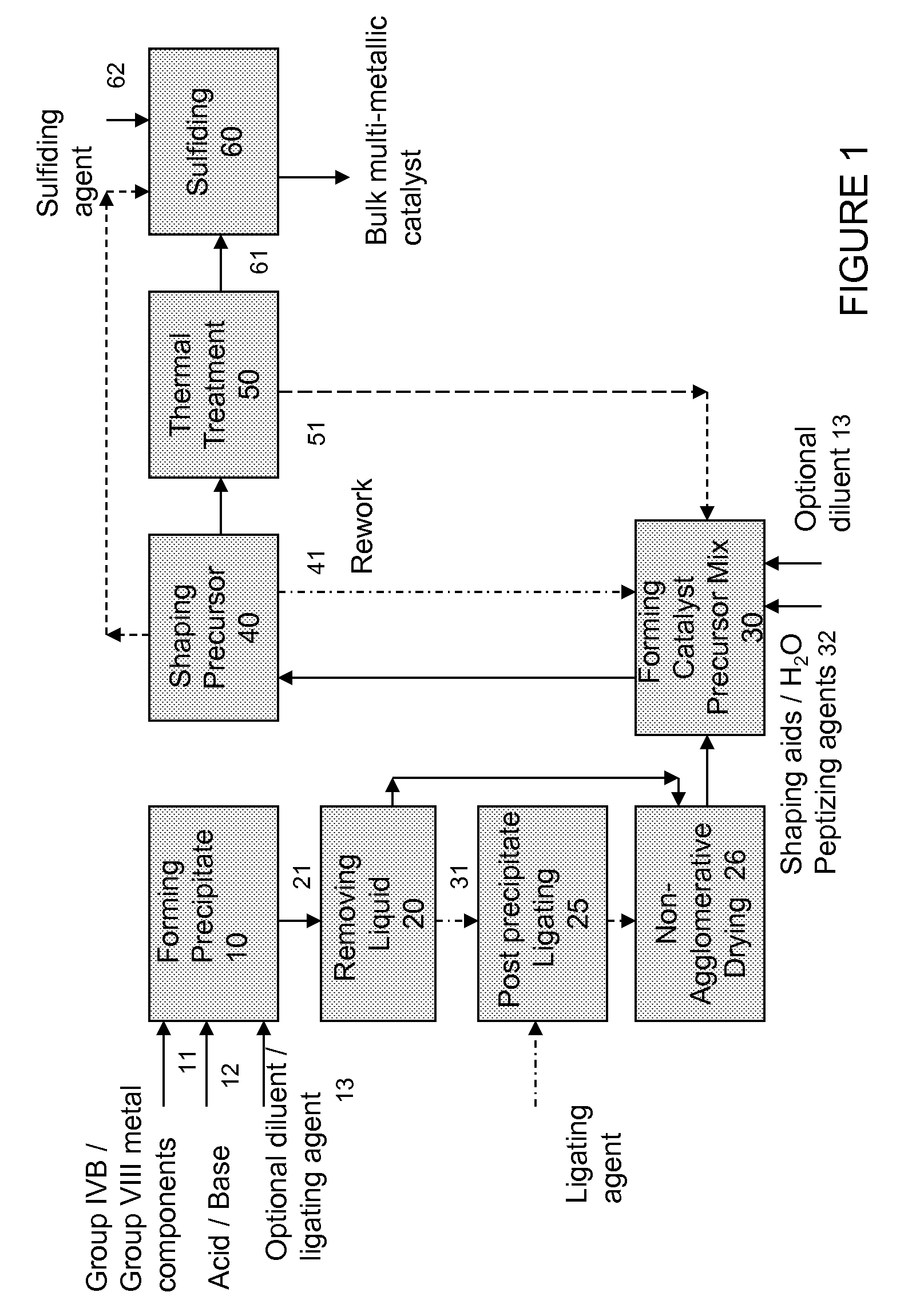Hydroconversion multi-metallic catalyst and method for making thereof
a multi-metallic catalyst and catalyst technology, applied in the direction of physical/chemical process catalysts, organic compounds/hydrides/coordination complexes catalysts, metal/metal-oxides/metal-hydroxide catalysts, etc., can solve the problems of catalyst being too porous, catalyst having a lot of surface area, and little in terms of surface area
- Summary
- Abstract
- Description
- Claims
- Application Information
AI Technical Summary
Problems solved by technology
Method used
Image
Examples
example 1
Ni—Mo—W-Maleate Catalyst Precursor
[0071]A catalyst precursor of the formula (NH4) {[Ni2.6(OH)2.08(C4H2O42−)0.06] (Mo0.35W0.65O4)2} was prepared as follows: 52.96 g of ammonium heptamolybdate (NH4)6Mo7O24.4H2O was dissolved in 2.4 L of deionized water at room temperature. The pH of the resulting solution was within the range of 2-3. 52.96 g of ammonium heptamolybdate (NH4)6Mo7O24.4H2O was dissolved in the above solution. The pH of the resulting solution was within the range of 5-6. 73.98 g of ammonium metatungstate powder was then added to the above solution and stirred at room temperature until completely dissolved. 90 ml of concentrated (NH4)OH was added to the solution with constant stirring. The resulting molybdate / tungstate solution was stirred for 10 minutes and the pH monitored. The solution had a pH in the range of 9-10. A second solution was prepared containing 174.65 g of Ni(NO3)2.6H2O dissolved in 150 ml of deionized water and heated to 90° C. The hot nickel solution was ...
example 2
Ni—Mo—W Catalyst Precursor
[0072]A catalyst precursor of the formula (NH4) {[Ni2.6(OH)2.08](Mo0.35W0.65O4)2} was prepared as follows: 52.96 g of ammonium heptamolybdate (NH4)6Mo7O24.4H2O was dissolved in 2.4 L of deionized water at room temperature. The pH of the resulting solution was within the range of 5-6. 73.98 g of ammonium metatungstate powder was then added to the above solution and stirred at room temperature until completely dissolved. 90 ml of concentrated (NH4)OH was added to the solution with constant stirring. The resulting molybdate / tungstate solution was stirred for 10 minutes and the pH monitored. The solution had a pH in the range of 9-10. A second solution was prepared containing 174.65 g of Ni(NO3)2.6H2O dissolved in 150 ml of deionized water and heated to 90° C. The hot nickel solution was then slowly added over 1 hr to the molybdate / tungstate solution. The resulting mixture was heated to 91° C. and stirring continued for 30 minutes. The pH of the solution was in...
example 3
Ni—Mo—W Maleate Catalyst Precursor—Post Precipitate Chelating
[0073]The precipitate of Example 2 was dispersed into a solution of 10.54 g of maleic acid dissolved in 1.8 L of DI water and heated to 70° C. The resulting slurry was stirred for 30 min. at 70° C. then filtered.
PUM
| Property | Measurement | Unit |
|---|---|---|
| temperature | aaaaa | aaaaa |
| density | aaaaa | aaaaa |
| density | aaaaa | aaaaa |
Abstract
Description
Claims
Application Information
 Login to view more
Login to view more - R&D Engineer
- R&D Manager
- IP Professional
- Industry Leading Data Capabilities
- Powerful AI technology
- Patent DNA Extraction
Browse by: Latest US Patents, China's latest patents, Technical Efficacy Thesaurus, Application Domain, Technology Topic.
© 2024 PatSnap. All rights reserved.Legal|Privacy policy|Modern Slavery Act Transparency Statement|Sitemap

